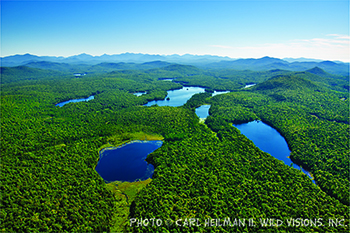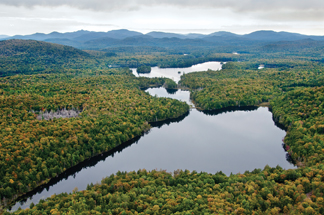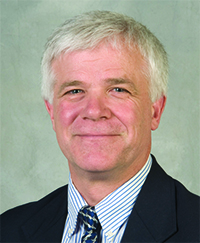
How the Deal Was Done
Monday, May 16, 2016
By: Joe Martens - Senior Fellow at the Open Space Institute
This essay was orginally published in the May edition of the Adirondack Explorer.
 For nine years, an epic conservation story has been unfolding that involved high finance, high risk, and intriguing politics at both the state and local levels. Although the last chapter has yet to be written, the story’s end is near. The state Department of Environmental Conservation (DEC) recently completed the largest addition to the Forest Preserve in a century by acquiring the fifth and last installment of the fabled Finch, Pruyn lands from the Nature Conservancy (TNC).
For nine years, an epic conservation story has been unfolding that involved high finance, high risk, and intriguing politics at both the state and local levels. Although the last chapter has yet to be written, the story’s end is near. The state Department of Environmental Conservation (DEC) recently completed the largest addition to the Forest Preserve in a century by acquiring the fifth and last installment of the fabled Finch, Pruyn lands from the Nature Conservancy (TNC).
Although each acquisition included land of spectacular beauty and ecological diversity, the Boreas Ponds Tract is arguably the crown jewel of Finch Pruyn’s Adirondack holdings. TNC held the best for last.
As a newly appointed DEC commissioner, I was with Governor Andrew Cuomo on August 5, 2012 when he announced that the state would buy sixty-nine thousand acres from TNC to add to the Forest Preserve. This announcement was a huge relief to the conservancy, which in 2007 bought all 161,000-acres of Finch’s holdings in the Adirondack Park in a $110 million deal.
The Adirondack chapter of TNC borrowed the funds to finance the transaction in part from the Open Space Institute in the hope of recouping its investment when it sold the land to the state, local governments, and a private concern committed to sustainable forestry.
The scope of this deal and the level of community participation were unprecedented in Park history: the Finch lands spanned six counties and twenty-seven towns, included 415 miles of rivers and streams, three hundred lakes and ponds, ninety peaks, and sixteen thousand acres of wetlands. More than 80 percent of the property lay within the five towns of Newcomb, North Hudson, Minerva, Indian Lake, and Long Lake.
To his great credit, Mike Carr, executive director of TNC’s Adirondack chapter, and the staffs of TNC and DEC set the table for the state’s acquisition. They met repeatedly with the town leaders and local residents, solicited their input, heard their concerns, and ultimately crafted a disposition plan that was approved by all twenty-seven towns. But the market crash in 2008 dimmed TNC’s hope of selling conservation easements and land to the state as soon as hoped.
Consequently, it was not until the waning days of 2010 that TNC was able to sell a conservation easement to the state that permanently protected ninety-one thousand acres.
The economic picture was still bleak when Governor Cuomo took office in 2011, and so the prospect of the state’s buying sixty-nine thousand acres for the Forest Preserve remained questionable. Grasping the importance of this deal, the governor placed the highest priority on working with the host towns to ensure that the ultimate land-use classification and management plan for the land would help them. This is what distinguishes this acquisition from all others in the history of the Park: we strove to show local leaders, by our words and our actions, that protecting natural resources can benefit the economy. Put another way, local officials’ views mattered.
In late 2012, DEC bought the 19,600-acre Essex Chain Lakes Tract in Hamilton and Essex counties. Off limits to the public for centuries, the Essex Chain had it all: a network of woods roads that could accommodate bicycles and horses; a series of lakes ideal for a limited number of paddlers, anglers, and tent campers; a largely pre-existing road corridor that could be used to connect Indian Lake, Newcomb, and Minerva with a long-distance snowmobile trail; and a remote stretch of the Hudson River for backcountry paddling and rafting.

In an unprecedented move, the governor personally met with the Adirondack Council, Adirondack Mountain Club, and local officials. DEC then worked closely with the Adirondack Park Agency, local governments, and conservation groups to develop a classification plan that would protect natural resources and accommodate appropriate recreational uses. The classification ultimately approved by the governor created two new Primitive Areas (that will be combined), expanded a Wilderness Area, kept the Essex Chain Lakes motor-free, and designated Wild Forest Areas where more intense recreational uses would not damage natural resources. DEC then prepared a unit management plan consistent with the classification.
Despite the resounding win for increased access to the Forest Preserve and natural resource protection, I was extremely disappointed that Earth Justice challenged the management plan in court on behalf of Protect the Adirondacks and Adirondack Wild.
These groups are missing an important point and an opportunity. Since Governor Cuomo has taken office, there has been a sea change in the state’s relationship with Adirondack Park residents and their elected officials. The state is working with them, not against them. By incorporating their interests and concerns into the classification and planning process, the state both honors the sanctity of the Forest Preserve and promotes community development.
The environmental community needs to engage with the towns. The future of the Park depends on harmonizing natural-resource protection with the Forest Preserve’s recreational and economic potential.
|
Would you like to comment on what you've read or viewed? We'd love to hear from you. Please click to send us a message.
|
|||

 Joe Martens served as NYS Commissioner of the Department of Environmental Conservation from March 2011 through July 2015 and is now a Senior Fellow at the
Joe Martens served as NYS Commissioner of the Department of Environmental Conservation from March 2011 through July 2015 and is now a Senior Fellow at the 


